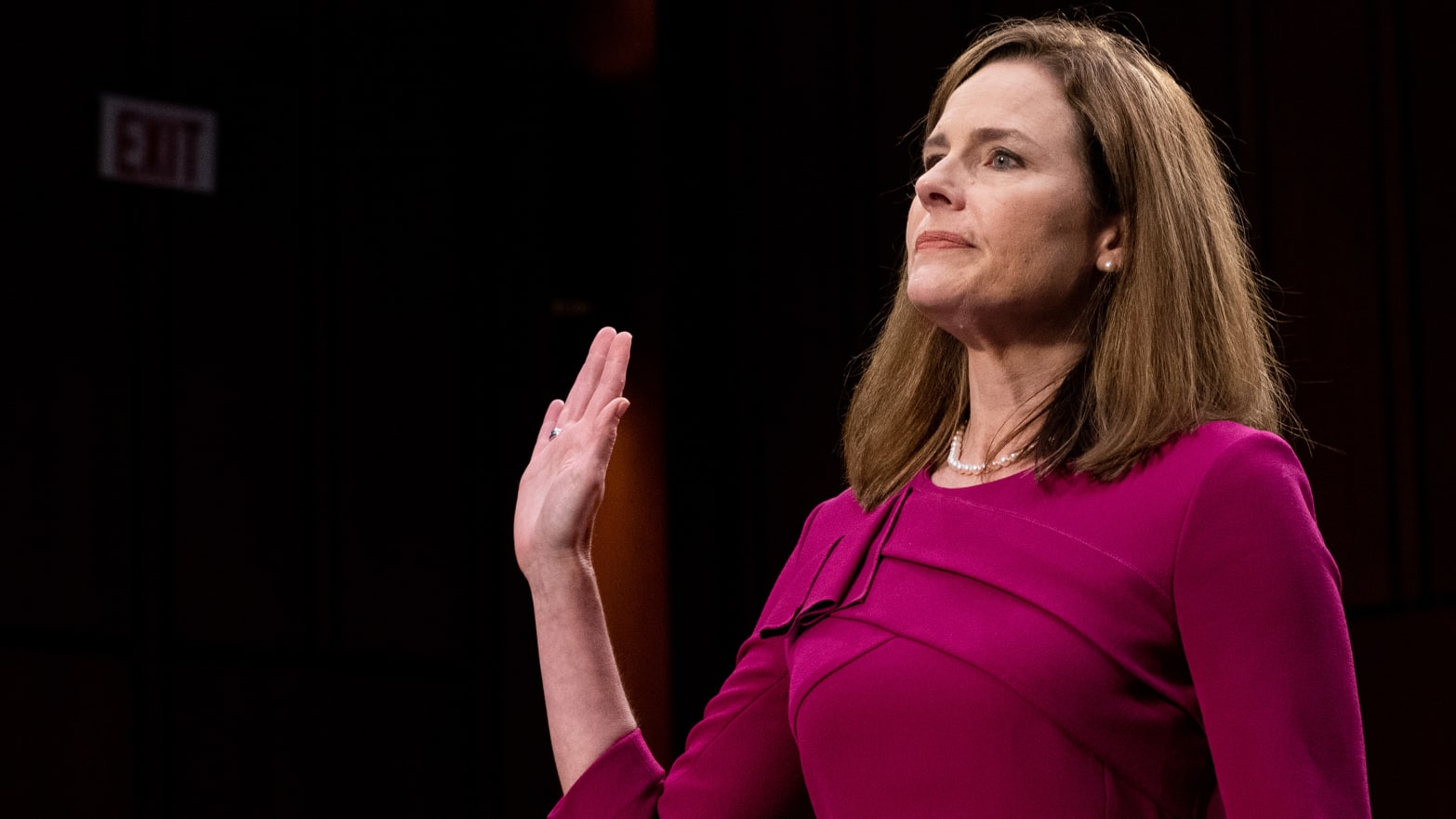With Democrats powerless and Republicans shameless, the foregone conclusion of Amy Coney Barrett’s confirmation as a Supreme Court justice is, at last, concluded.
Justice Barrett was confirmed 52-48 by the Senate, and fittingly, given her shotgun-wedding of a confirmation, may begin deciding cases tomorrow, including two high-profile challenges to election rules.
Before the travesty fades from memory, however, we thought it would be useful to put all of the terribleness of her confirmation into one convenient top-ten list, summarizing everything that was wrong with this process from its beginning—all of one month ago—to now. Shall we?
1. Hypocrisy: President Barack Obama nominated Judge Merrick Garland on March 16, 2016. Republicans said that was too close to an election to confirm a new justice. Some even promised not to do so in 2020. Justice Barrett was nominated on September 29.
2. Disrespect: The actual, for-real dying wish of the late Justice Ruth Bader Ginsburg was that she not be replaced until after the election. Barrett’s nomination was announced three days after Ginsburg died, before she had even been buried.
3. Haste: In order to ram through their nominee before the election—it was the fastest nomination process since 1975—Republicans cut corners everywhere, with little investigation, a perfunctory and incomplete questionnaire, and a bogus process.
4. Magical Thinking: Because of the COVID-19 pandemic having spread to the Senate floor, the Senate was actually not in session while the Barrett confirmation hearings took place. How were senators both in session and not in session at the same time? Magic, I guess.
5. Anti-Life: Speaking of the pandemic, two members of the Judiciary Committee had COVID-19 during the confirmation process. One attended a hearing in person. Barrett’s nomination party was a super-spreader event. So much for “pro-life.” Meanwhile, the Senate did nothing to pass additional Coronavirus relief, because Majority Leader Mitch McConnell worried that however it went, the vote might hurt Republicans’ reelection chances.
6. Evasion: More than any other nominee in history, Justice Barrett dodged every question of any substance. She said nothing about Obamacare, abortion, even the peaceful transition of power.
7. Denial: Despite Trump and the Republican platform explicitly promising that he would appoint judges to overturn Obamacare and Roe v. Wade, Republican senators, and Justice Barrett, clutched their pearls in astonishment that anyone would ever suggest such a thing.
8. Puppet Theater: Except for a brilliant half-hour lecture by Senator Sheldon Whitehouse, hardly anyone mentioned the dark-money-funded networks, staffed by religious extremists, that have now placed three justices on the Supreme Court (and dozens on other courts) and that often bring the conservative-activist cases that their handpicked justices then decide.
9. Anti-Democracy: Republican presidents have now placed 15 of the last 19 justices on the court, despite losing the popular vote in 6 of the last 7 presidential elections. The Republican majority in the Senate represents 15 million fewer people than the Democrat minority. Our system, designed in the 18th century, never anticipated this.
And most importantly:
10. Delegitimization: Despite the best efforts of Chief Justice John Roberts, the Supreme Court has again lost legitimacy in the eyes of the American public. All three Trump justices are under a cloud: the first is in a seat stolen from President Obama; the second was pushed through despite serious rape allegations, which have only been further corroborated since his confirmation; and the third was appointed to the Court with all the seriousness and deliberation of a Las Vegas wedding.
And the reasons are transparently anti-democratic: to end abortion, same-sex marriage, Obamacare, civil rights laws, voting rights laws, environmental regulations, gun control, campaign finance regulations, compassionate immigration laws, labor laws, and all the other things that large majorities of Americans support and the Republican party opposes.
Make no mistake: All of these are on the Court’s docket, either now or in the immediate future, and if this 6-3 majority is allowed to stand, they will indeed end.
In the short term, Justice Barrett may rule on two pending election challenges from Republicans, who are trying to stop as many people from voting as they can. Just as the Senate was voting on her confirmation, Justice Brett Kavanaugh authored an opinion on a third one, throwing out an extended deadline for mail-in ballots in Wisconsin.
For good measure, Justice Kavanaugh cited Bush v. Gore, which he helped to litigate in 2000, for the principle that the Supreme Court can overturn state courts’ election-law decisions if need be. Because look how well that turned out the last time.
A similar case is pending from Pennsylvania after an earlier 4-4 deadlock, which Justice Barrett may now break. That’s right, Justice Barrett’s first act may be to make it harder for people to vote.
The Supreme Court’s ultra-conservative supermajority doesn’t think like America, doesn’t look like America (racially, religiously, or in countless other ways), and doesn’t interpret the Constitution in a way that makes sense in America. (“Originalism” is preposterously selective–to take but one example, there’s no right to corporate personhood, or even corporations existing, in the Constitution, because the Founders generally hated corporations and thought they shouldn’t exist. But try telling that to the “Originalists” on the Court.)
But then again, neither do Republicans. The Grand Old Party is looking especially Old these days, is likely to lose big in next week’s election, and if Republicans don’t find a way to broaden their appeal beyond Trump’s rabid base of non-college-educated, mostly-older white men, together with their wives and assorted religious extremists, they’re going to lose even bigger in elections to come.
That’s true even if their hand-picked Court allows them to gerrymander, suppress the vote, and allow unlimited dark money to manipulate our elections. Which it has already been doing. It just might take a little longer.
Fortunately, even moderate Democrats are now out for blood. After Garland/Gorsuch, Kavanaugh, and now Barrett, there is growing support for increasing the size of the Court, imposing term limits on justices, or both. (My own proposal: immediate term limits for all justices, which would create two immediate vacancies.)
No doubt, Republicans will cry that Democrats are threatening the legitimacy of the Supreme Court. They’re exactly wrong. In fact, structural change is the only way to restore it.

